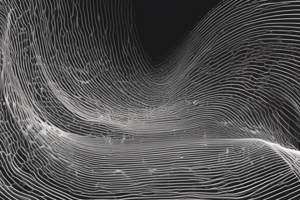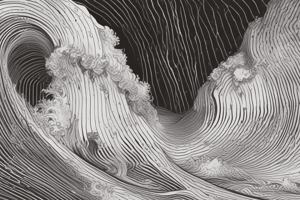Podcast
Questions and Answers
What type of wave is a sound wave?
What type of wave is a sound wave?
- Surface wave
- Electromagnetic wave
- Mechanical wave (correct)
- Transverse wave
What happens to sound waves in a vacuum?
What happens to sound waves in a vacuum?
- They are reflected.
- They can be amplified.
- They travel faster.
- They cannot be produced. (correct)
What are the components of a longitudinal wave?
What are the components of a longitudinal wave?
- Crests and troughs
- Compressions and rarefactions (correct)
- Wavelengths and amplitudes
- Nodes and antinodes
Which of the following frequencies is classified as infrasound?
Which of the following frequencies is classified as infrasound?
How do sound waves propagate from their source?
How do sound waves propagate from their source?
Flashcards are hidden until you start studying
Study Notes
Sound Wave Characteristics
- Sound waves are mechanical or longitudinal waves caused by vibrating bodies that travel through a medium.
- In a vacuum, no sound can be made because there are no particles to vibrate.
- Longitudinal waves have particles of a medium vibrating in the same direction as the wave travel.
- Sound waves are made up of compressions (particles compressed together) and rarefactions (particles spread out).
Sound Wave Propagation
- Sound waves travel in all directions away from their source.
Types of Sound Waves
- Sound waves have frequencies between 20 Hz and 20 kHz, which is the normal hearing range.
Infrasound
- Infrasound refers to sound frequencies below 20 Hz, which is below the normal hearing range.
Ultrasound
- Ultrasound ranges above 20 kHz, which is above the normal hearing range.
Studying That Suits You
Use AI to generate personalized quizzes and flashcards to suit your learning preferences.




